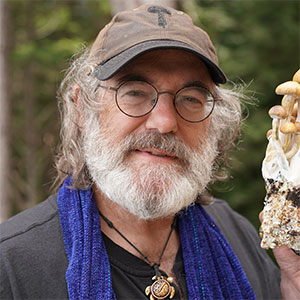“We need to have a paradigm shift in our consciousness. If we don’t get our act together, and come in commonality and understanding with the organisms that sustain us today, not only will we destroy those organisms, but we will destroy ourselves.”
Biography
Paul Stamets, speaker, author, mycologist, medical researcher and entrepreneur, is considered an intellectual and industry leader in fungi: habitat, medicinal use, and production. He lectures extensively to deepen the understanding and respect for the organisms that literally exist under every footstep taken on this path of life. His presentations cover a range of mushroom species and research showing how mushrooms can help the health of people and planet. His central premise is that habitats have immune systems, just like people, and mushrooms are cellular bridges between the two. Our close evolutionary relationship to fungi can be the basis for novel pairings in the microbiome that lead to greater sustainability and immune enhancement.
Paul’s philosophy is that “MycoDiversity is BioSecurity.” He sees the ancient Old Growth forests of the Pacific Northwest as a resource of incalculable value, especially in terms of its fungal genome. A dedicated hiker and explorer, his passion is to preserve and protect as many ancestral strains of mushrooms as possible from these pristine woodlands. His research is considered breakthrough by thought leaders for creating a paradigm shift for helping ecosystems survive worldwide.
Revisiting the McKenna Stoned Ape Theory: The ever evolving case for its plausibility.
“Five hundred years ago, Aztecs were first documented to use psilocybin mushrooms and chocolate, a practice that continues to this day.”
Transcript Abstract
When Terence and Dennis McKenna first proposed The Stoned Ape Theory circa 1977, it was contemporaneously celebrated by the psychedelic subculture and ridiculed by academics. Was this far fetched idea so far removed from probability to be considered seriously, scientifically? Or, were they right in that psilocybin use by our primate ancestors stimulated an increase in intelligence and help hominids evolve into Homo sapiens? Increasingly, the evidence on the profound neurogenerative properties of psilocybin mushrooms – and their numerous analogs – suggests that the McKennas’ concepts were not so far fetched. What is different now is that we have identified multiple modes of action showing psilocybin analogs stimulate neurogenesis and neurogeneration. Psilocybin analogs stimulate proteins that code for NGF (Nerve Growth Factors) and BDNF (Brain Derived Nerve Factors). Moreover, not one region of the brain, but receptors across diverse regions of the nervous system are activated upon contact.
Five hundred years ago, Aztecs were first documented to use psilocybin mushrooms and chocolate, a practice that continues to this day. Currently popular is ‘stacking’ psilocybin with other substances, especially with low doses. Microdosing is sub-sensorium – below the threshold of intoxication but not below feeling positive effects. Large meta-studies comparing psilocybin microdosers from non-microdosers reveal trends showing improvements in depression, anxiety, psychological health and surprisingly motor skills. Is microdosing with psilocybin helpful neurologically? Microdosing and “stacking” – typically microdosing small amounts of psilocybin with other substances – are increasing in popularity. The most widely used combination is a stack with niacin (vitamin B3), Lion’s Mane and other mushrooms. Compared to psilocybin mushrooms alone, this stack shows neurostimulation is synergistically enhanced far beyond baselines.

